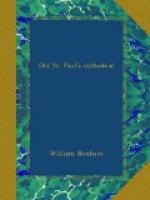We must not omit mention of John Tomkins, Organist of the Cathedral. He died in 1638. His epitaph says that he was the most celebrated organist of his time. He succeeded Orlando Gibbons at King’s College, Cambridge, in 1606, and came to St. Paul’s in 1619. His compositions, though good, are not numerous, but he is said to have been a wonderful executant.
But we must now approach the final scenes of Old St. Paul’s. At the Restoration, Sheldon was made Bishop of London, and two years later, on his translation to Canterbury, was succeeded by Humphrey Henchman, a highly respectable man, who owed his elevation to his loyalty to the Stuarts during the Commonwealth. He took no part in public affairs, but was a liberal contributor to the funds of the cathedral. The Dean, John Barwick, was a good musician, and restored the choir of the cathedral to decent and orderly condition. But it was soon found that the building was in an insecure, indeed dangerous condition, and it became a pressing duty to put it in safe order. Inigo Jones had died in 1652, and the Dean, Sancroft, who had succeeded Barwick in 1664, called on Dr. Christopher Wren to survey the cathedral and report upon it.
This famous man was the son of the Rector of East Knoyle, in Wilts, and was born in 1632. His father had some skill in architecture, for he put a new roof to his church, and he taught his son to draw, an art in which he displayed extraordinary skill and taste. He was sent to Westminster School, and, under the famous Busby, became a good scholar. Then he went to Wadham College, Oxford, the Master of which, Wilkins, aftewards (sic) Bishop of Chester, was a great master of science. Wren took advantage of his opportunities, and became so well known for his acquirements in mathematics and his successful experiments in natural science that he was elected to a Fellowship at All Souls’. A few years later he was appointed to the Professorship of Astronomy at Gresham College, and his brilliant reputation made his rooms a meeting-place of the men who subsequently founded the Royal Society. A fresh preferment, that to the Chair of Savilian Professor of Astronomy at Oxford, did not hinder him from pursuing a fresh line. His father, as we have said, taught him to draw, his mathematical skill guided his judgment in construction, and these two acquirements turned him more and more towards architecture, though even now he was held second only to Newton as a philosopher. His first appearance as an architect was his acceptance of the post of Surveyor of King Charles II.’s public works. This was in 1661. He lost no time in starting in his new profession, for in 1663 he designed the chapel of Pembroke College, Cambridge, which his uncle Matthew gave, and the Sheldonian Theatre at Oxford. This, then, brings him down to the survey of St. Paul’s above named. It was carefully made, and presented in May, 1666. How he designed to rebuild some portions which were decayed, to introduce more light, to cut off the corners of the cross and erect a central dome—all this boots not now to tell. The plans were drawn, and estimates were ordered on Monday, August 27th, 1666.




